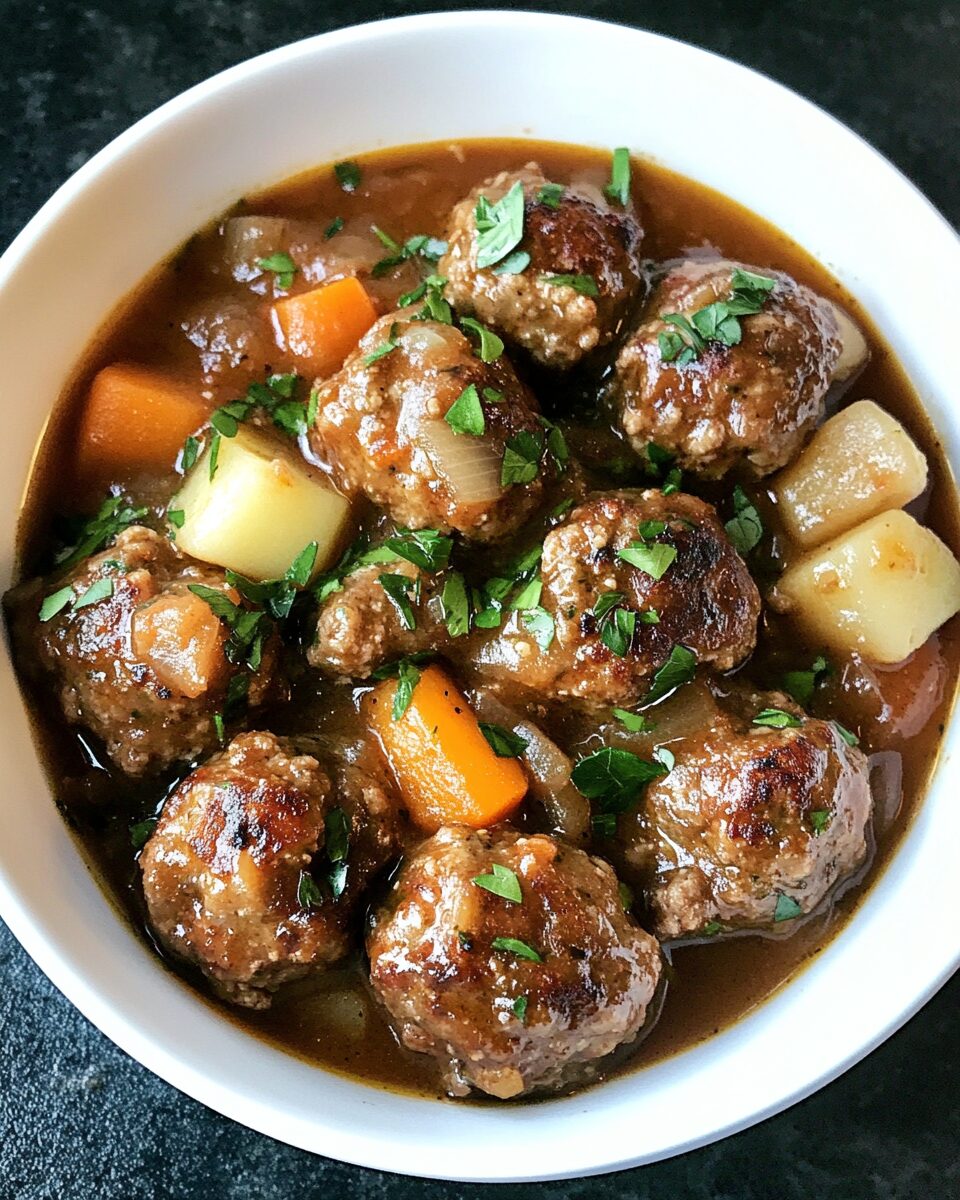The rich, soul warming flavor of traditional Irish stew meets the cozy familiarity of meatballs in this comforting dish. Made with a blend of ground lamb and beef, and simmered gently in a hearty Guinness based gravy, these meatballs soak up all the deep, savory notes of a classic Irish supper.
Ideal for a chilly evening or a festive gathering, this recipe balances traditional Irish ingredients with gluten free convenience. Root vegetables like carrots and potatoes add heartiness, while fresh herbs elevate every bite. Whether you’re celebrating your heritage or just want a filling, satisfying meal, these Irish Stew Meatballs deliver.
Full Recipe:
Ingredients:
-
1 lb ground beef
-
1 lb ground lamb
-
1/2 cup gluten-free breadcrumbs
-
1 egg
-
1/2 tsp salt
-
1/2 tsp pepper
-
1 tbsp fresh thyme, chopped
-
1 tbsp fresh parsley, chopped
-
1 tbsp oil for frying
-
1 onion, diced
-
2 cloves garlic, minced
-
2 tbsp tomato paste
-
1 cup Guinness (or gluten-free dark beer or beef broth)
-
2 cups beef stock
-
2 tbsp gluten-free flour (or cornstarch slurry)
-
4 carrots, peeled and sliced
-
2 potatoes, diced
-
1/2 tsp paprika
-
Salt and pepper to taste
Directions:
-
In a large bowl, combine the ground beef, lamb, gluten-free breadcrumbs, egg, salt, pepper, thyme, and parsley. Mix well and shape into meatballs.
-
Heat oil in a large skillet over medium-high heat. Sear the meatballs in batches until browned on all sides. Set aside.
-
In the same skillet, sauté onion and garlic until fragrant and translucent.
-
Stir in the tomato paste and cook for 1-2 minutes. Add the Guinness and beef stock, scraping the bottom to deglaze.
-
Bring to a simmer and add carrots, potatoes, paprika, salt, and pepper. Let simmer for 10 minutes.
-
Return meatballs to the pot, cover, and simmer for 20-25 minutes until vegetables are tender and meatballs are cooked through.
-
If needed, thicken with gluten-free flour or cornstarch slurry.
-
Garnish with fresh parsley and serve hot.
Prep Time: 20 minutes | Cooking Time: 35 minutes | Total Time: 55 minutes
Kcal: 410 kcal | Servings: 6 servings
The Comforting Tradition of Irish Stew Reimagined
There are few dishes more comforting and steeped in tradition than Irish stew. Originating from humble beginnings in rural Ireland, this dish has come to symbolize warmth, heritage, and culinary simplicity. Traditionally made with lamb or mutton, potatoes, and root vegetables like carrots and onions, Irish stew was a way for families to stretch their food resources while still creating a hearty, filling meal. The beauty of this stew lies in its rustic nature and ability to be modified depending on the availability of ingredients. Over time, the dish has traveled the world, adapting to modern tastes and dietary needs like this gluten free twist with Irish Stew Meatballs.
In this unique take on Irish stew, the classic components are deconstructed and reassembled into something even more inviting: perfectly seasoned meatballs simmered in a thick, savory gravy packed with the familiar flavors of a traditional Irish stew. The dish not only retains the soul of the original stew but elevates it to new culinary heights, making it ideal for weeknight dinners, St. Patrick’s Day feasts, or any time you’re craving something wholesome and hearty.
The Evolution of the Dish
Historically, Irish stew was a product of necessity, born out of limited access to expensive cuts of meat. Irish farmers often used the neck or shank of lamb or mutton, which required long, slow cooking to tenderize. As the dish made its way into urban kitchens and eventually international cuisine, cooks began experimenting with other meats and thickening agents to create richer, more indulgent versions. The gluten-free Irish Stew Meatballs continue this tradition of evolution.
This version introduces gluten-free meatballs, which make the dish more accessible for those with gluten sensitivities or celiac disease. By replacing breadcrumbs with gluten-free alternatives or omitting them entirely in favor of egg and potato for binding you can ensure the dish maintains its integrity without sacrificing texture or flavor. It’s a prime example of how heritage recipes can be modified for modern dietary needs without compromising authenticity.
Why Meatballs?
The decision to transform the protein component of Irish stew into meatballs is both creative and practical. Meatballs allow for an even distribution of flavors, especially when infused with traditional seasonings like thyme, rosemary, and garlic. They also offer portion control and an aesthetic appeal that elevates the dish visually. In addition, meatballs cook faster than large cuts of lamb or beef, making this recipe more feasible for busy households without requiring long simmering times.
From a culinary standpoint, meatballs also absorb the stew’s gravy beautifully, becoming tender and infused with flavor. This results in a multi-textured dish where every bite carries the essence of the broth, vegetables, and herbs. The surface of each meatball slightly caramelizes during browning, which enhances the Maillard reaction and introduces a deep umami note into the final stew.
Nutritional Balance and Gluten Free Appeal
One of the highlights of this dish is its nutritional balance. Lean meatballs made from quality ground beef or lamb offer ample protein, while the stew’s vegetable base provides fiber, vitamins, and minerals. Carrots and onions deliver beta-carotene and antioxidants, while potatoes bring satiating complex carbs. The broth, typically made from a gluten-free beef or vegetable stock, is light yet full-bodied, creating a comforting base without being overly rich.
Many people seeking gluten-free recipes struggle to find dishes that feel indulgent and satisfying, especially comfort foods. This stew breaks that barrier. It proves that gluten-free doesn’t have to mean flavor-free or restrictive. On the contrary, the rich depth of taste in this dish makes it a go-to for both gluten-free eaters and those simply looking for a hearty, home-cooked meal.
Cultural Connection and Modern Relevance
Food is one of the most powerful ways to connect with culture and heritage. For those with Irish roots or anyone who simply enjoys celebrating Irish culture this dish offers a taste of history with a modern twist. Whether you’re preparing it as part of a St. Patrick’s Day menu, for a family gathering, or just to explore global comfort foods, the Irish Stew Meatballs are a conversation starter.
In today’s culinary landscape, fusion and adaptation are becoming more and more important. People are seeking new ways to enjoy their cultural favorites in alignment with their health goals or dietary restrictions. Recipes like this one sit at the intersection of heritage and health, offering the best of both worlds.
Tips for Perfecting the Dish
-
Use High-Quality Meat: Choose lean but not overly dry cuts. Ground beef with a bit of fat (about 85/15) or a mix of beef and pork can offer a richer flavor and tender bite.
-
Brown the Meatballs First: This step locks in flavor and adds color. It also prevents them from falling apart during simmering.
-
Cook Low and Slow: While this stew doesn’t require hours on the stove, allowing the meatballs to simmer gently in the broth for 20–30 minutes helps deepen the flavor.
-
Go Fresh with Herbs: If you have access to fresh thyme and rosemary, use them. They make a noticeable difference in aroma and flavor.
-
Customize the Veggies: While carrots, potatoes, and onions are traditional, you can add parsnips, turnips, peas, or even celery root for variation.
Pairing Suggestions
The Irish Stew Meatballs are a full meal in a bowl, but that doesn’t mean you can’t add a few accompaniments to round out your dining experience.
-
Serve with Irish Soda Bread: A gluten-free version, of course. The mild tang and dense crumb of soda bread is perfect for mopping up the thick gravy.
-
Side Salad: A crisp green salad with a lemon vinaigrette can cut through the richness of the stew, providing a refreshing balance.
-
Drink Pairing: This dish pairs wonderfully with a smooth Irish red ale or a glass of hearty red wine. For non-alcoholic options, a cold apple cider or sparkling water with lime works beautifully.
Storage and Make Ahead Tips
This stew stores beautifully. In fact, many would argue it tastes even better the next day, as the flavors meld and intensify overnight. You can refrigerate leftovers for up to 4 days or freeze them for up to 3 months.
If you’re hosting a party or cooking in advance, consider making the meatballs and chopping the vegetables ahead of time. Store them separately in airtight containers in the refrigerator, then assemble and simmer the dish just before serving.
Conclusion:
The Gluten Free Irish Stew Meatballs offer a fresh, flavorful, and inclusive twist on one of Ireland’s most iconic dishes. By transforming the classic stew into a meatball-based meal, you get a dish that’s not only beautiful to serve but incredibly satisfying to eat. With rich gravy, tender vegetables, and meatballs infused with traditional herbs, it brings together comfort, nostalgia, and innovation in every bite.
Whether you’re honoring Irish heritage, looking for a cozy gluten free dinner idea, or simply want to add a hearty stew to your weekly menu, this recipe ticks every box. It’s accessible, adaptable, and absolutely delicious a modern classic that belongs in every home cook’s rotation.






